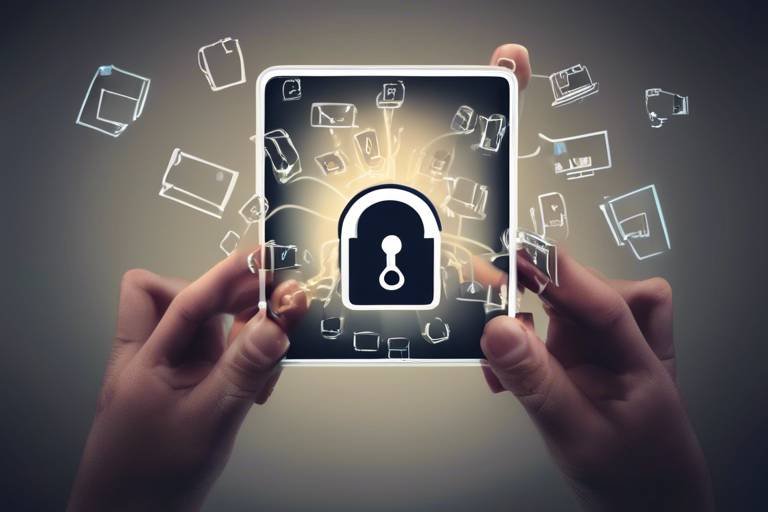What to Do If Your Personal Information Has Been Compromised?
In today's digital age, the threat of having your personal information compromised is more real than ever. Imagine waking up one day to find that your bank account has been drained, or worse, your identity has been stolen. It can feel like a punch to the gut, leaving you anxious and unsure of what to do next. But don’t panic! There are essential steps you can take to regain control and protect yourself from further harm. This article will guide you through the crucial actions to take immediately, preventive measures to consider for the future, and resources available for recovery and support.
Understanding the signs of a data breach is crucial. You might be wondering, "How do I know if I've been compromised?" Some common indicators include:
- Unusual account activity, such as transactions you didn’t make.
- Receiving notifications about password changes that you didn’t initiate.
- Alerts from your bank or credit card company regarding suspicious transactions.
- Emails or messages from companies stating that your information may have been involved in a data breach.
Recognizing these signs early can be the difference between a minor inconvenience and a major crisis. If you notice any of these indicators, it's essential to act swiftly.
When you suspect a breach, acting quickly is vital. The first step is to change your passwords. This simple action can prevent unauthorized access to your accounts. But not just any password will do! You need to create strong, unique passwords for each of your accounts. Think of your password as the key to your digital house; you wouldn't want just anyone to have a copy of it. Use a mix of letters, numbers, and symbols, and avoid using easily guessed information like birthdays or pet names.
Once you've decided to change your passwords, consider these best practices:
- Use at least 12 characters.
- Incorporate upper and lower case letters, numbers, and special characters.
- Avoid using the same password across multiple sites.
By following these guidelines, you can create a fortress around your accounts, making it much harder for hackers to break in.
Managing multiple strong passwords can be a hassle, and that's where password managers come in. These tools securely store your passwords and can even generate complex ones for you. When choosing a password manager, look for one that offers strong encryption and a user-friendly interface. Using a password manager is like having a digital vault for all your keys—secure, convenient, and essential for your online safety.
Another layer of security is two-factor authentication (2FA). This method requires not just your password but also a second form of verification, such as a code sent to your phone. Setting up 2FA is a straightforward process, and it significantly enhances your account's security. Think of it as having a double lock on your door; even if someone has your key (your password), they still can’t get in without the second key (the verification code).
Keeping a close eye on your financial accounts is essential after a breach. Regularly check your bank statements and credit card transactions for any suspicious activity. If you notice anything out of the ordinary, report it immediately. You can also consider setting up alerts for transactions over a certain amount—this way, you'll be notified right away if something seems off.
Reporting the incident to relevant authorities is crucial. This not only helps you but also protects others from becoming victims. Start by reporting the breach to your bank and any other financial institutions involved. They can assist you in securing your accounts and may offer additional resources for protection.
Informing credit bureaus can help prevent identity theft. You can place a fraud alert on your credit report, which will make it harder for someone to open new accounts in your name. Alternatively, you can opt for a credit freeze, which restricts access to your credit report entirely. This is like putting a "Do Not Disturb" sign on your financial life—no one can access your credit without your permission.
Filing a police report provides documentation of the breach. This can be crucial for disputing fraudulent charges and clearing your name. When filing a report, be sure to include as much information as possible, including any evidence of the breach. This step may feel daunting, but think of it as taking a stand against the violation of your privacy.
Q: What should I do if I notice unauthorized transactions?
A: Report them immediately to your bank or credit card company. They can help you dispute the charges and protect your account.
Q: How can I prevent future breaches?
A: Regularly update your passwords, enable two-factor authentication, and monitor your financial accounts closely.
Q: Is it necessary to file a police report?
A: While it's not mandatory, having a police report can help in resolving disputes and protecting yourself against identity theft.

Recognizing a Data Breach
In today's digital age, recognizing a data breach is more crucial than ever. With cyber threats lurking around every corner, it’s essential to be vigilant about your personal information. So, how can you tell if your data has been compromised? There are several common indicators that can alert you to a potential breach. One of the first signs is receiving unexpected notifications regarding account activity. Perhaps you got an email about a password change that you didn’t initiate or a login attempt from a location you’ve never visited. These are red flags!
Another alarming sign is if you notice unusual charges on your bank statements. If your hard-earned money is disappearing or if you see transactions that you didn’t authorize, it’s time to take action. Similarly, if you receive credit card statements that seem off or if you’re denied credit for no apparent reason, it could indicate that someone is using your identity without your knowledge.
Moreover, keep an eye out for malicious emails or phishing attempts. If you start receiving strange emails that ask for personal information, be on high alert! Cybercriminals often use these tactics to gather your data. If you find that your social media accounts are behaving strangely, such as posts appearing that you didn’t create, or if your friends are receiving odd messages from you, these too can be signs that your accounts have been compromised.
Here are some additional signs to watch for:
- Unfamiliar devices logged into your accounts.
- Notifications from services about changes to your account settings.
- Being locked out of your accounts or having difficulty logging in.
Recognizing these signs early can make a significant difference in mitigating damage. It’s like being a detective in your own life—staying alert and piecing together clues can help you solve the mystery before it spirals out of control. Remember, if something feels off, trust your instincts and investigate further. The sooner you act, the better your chances of protecting your personal information.

Immediate Steps to Take
When you suspect that your personal information has been compromised, the clock is ticking. Acting quickly can make all the difference in minimizing the damage and protecting your identity. First and foremost, stay calm. Panic can cloud your judgment, and it’s essential to approach the situation with a clear mind. Think of it like a fire alarm going off in your home; you wouldn’t just stand there frozen in fear, right? You’d take action! Similarly, here’s what you should do:
Start by changing your passwords immediately. This is your first line of defense against further unauthorized access. Use a combination of uppercase letters, lowercase letters, numbers, and special characters to create a strong password. A good rule of thumb is to aim for at least 12 characters. If you’re using the same password across multiple accounts, it’s time to change that habit. Each account should have a unique password to minimize risk. Remember, your password is like a key to your house; if someone gets a hold of it, they can walk right in!
Now, let’s dive deeper into how to change your passwords effectively. Avoid using easily guessable information like birthdays or names of pets. Instead, consider using a passphrase—a series of random words that create a memorable sentence. For example, “PurpleElephantDances@Midnight!” is not only strong but also easier to remember than a random string of characters. Once you’ve updated your passwords, make sure to log out of all sessions on your devices to ensure that old sessions are terminated.
Keeping track of all these new passwords can be a hassle, which is where password managers come into play. These tools securely store your passwords and can even generate strong ones for you. When choosing a password manager, look for features like:
| Feature | Importance |
|---|---|
| Encryption | Protects your stored passwords from unauthorized access. |
| Cross-Device Sync | Ensures you have access to your passwords on all your devices. |
| User-Friendly Interface | Makes it easier to manage your passwords without confusion. |
Once you’ve selected a password manager, take the time to familiarize yourself with its features. This will make your life much easier and your accounts more secure.
Next, consider implementing two-factor authentication (2FA) on your accounts. This adds an extra layer of security by requiring not just your password but also a second form of verification—like a text message or an authentication app. Think of it as having a double lock on your front door; even if someone has the key (your password), they still can’t get in without the second lock (the 2FA code). Setting up 2FA is usually straightforward: just go to your account settings, find the security section, and follow the prompts to enable it.
After securing your accounts, it’s crucial to monitor your financial accounts closely. Check your bank statements, credit card transactions, and any other financial records for unusual activity. If you notice anything suspicious, report it immediately. This vigilance is akin to keeping a watchful eye on your garden after a storm; you want to catch any weeds before they take over.
In summary, when your personal information is compromised, swift action is your best ally. Change your passwords, utilize password managers, and implement two-factor authentication. These steps will help you regain control and protect your identity from further threats. Remember, being proactive today can save you from a lot of headaches tomorrow!
Q: What should I do if I notice unauthorized transactions?
A: Immediately contact your bank or credit card company to report the transactions. They can help you dispute the charges and secure your account.
Q: How can I tell if my information has been compromised?
A: Look for signs such as unexpected account activity, receiving alerts about password changes you didn’t make, or notifications from companies about data breaches.
Q: Is it safe to use public Wi-Fi after a breach?
A: It’s best to avoid public Wi-Fi for sensitive transactions until you’re sure your accounts are secure. If you must use it, consider using a VPN for added security.
Q: How often should I change my passwords?
A: It’s a good practice to change your passwords every 3-6 months, especially for sensitive accounts. If you suspect a breach, change them immediately.

Change Your Passwords
When you suspect that your personal information has been compromised, one of the first and most critical steps you can take is to . Think of your passwords as the locks on your doors; if someone has the key, it's time to change the locks! A strong password is like a fortress, keeping your sensitive information safe from prying eyes. But what makes a password strong? Well, it should be a mix of letters, numbers, and special characters. Ideally, it should be at least 12 characters long and not easily guessable. Avoid using personal information like your name or birthdate, as these can be easily obtained.
Once you’ve decided to change your passwords, it’s essential to do so across all accounts that may be at risk. This includes not just your email and banking accounts, but also social media, shopping sites, and any other platforms where your personal information is stored. A good rule of thumb is to never reuse passwords. Each account should have its unique password to minimize risk. If you’re struggling to remember all these different passwords, don't worry! There are tools designed to help you manage them securely.
Consider the following best practices when creating new passwords:
- Use a mix of characters: Combine uppercase letters, lowercase letters, numbers, and symbols.
- Avoid common words: Stay away from dictionary words or easily guessable phrases.
- Update regularly: Make it a habit to change your passwords every few months.
- Enable password recovery: Make sure you have recovery options set up in case you forget your new password.
After changing your passwords, it’s wise to enable two-factor authentication (2FA) wherever possible. This adds an extra layer of security by requiring a second form of verification, such as a text message code or an authentication app. Think of it as a double lock on your door. Even if someone manages to get a hold of your password, they won't be able to access your account without that second key.
Lastly, don't forget to keep a record of your new passwords in a secure location. You can use a password manager, which can generate strong passwords for you and store them in an encrypted format. This way, you only need to remember one master password to access all your accounts. Remember, taking these steps can significantly reduce your risk of identity theft and give you peace of mind.

Utilizing Password Managers
In today's digital age, where our lives are intertwined with technology, managing passwords can feel like juggling flaming torches while riding a unicycle. It’s tricky, and one misstep can lead to disaster. That’s where password managers come into play. They are like your personal vault, securely storing all your passwords in one place, so you don’t have to rely on your memory or write them down on sticky notes that could end up in the wrong hands.
Imagine having a single master password that unlocks a treasure trove of all your credentials, making it easier to maintain strong, unique passwords for each of your accounts. This approach significantly reduces the risk of falling victim to data breaches, as many people tend to reuse passwords across multiple sites, which is like using the same key for your house, car, and safe. If one lock is picked, everything is compromised!
When choosing a password manager, consider the following factors:
- Security Features: Look for end-to-end encryption and a zero-knowledge policy, meaning the provider cannot access your passwords.
- User Interface: A simple and intuitive interface can make all the difference, especially if you’re not tech-savvy.
- Cross-Platform Compatibility: Ensure it works seamlessly across all your devices, whether it’s a smartphone, tablet, or computer.
Once you’ve selected a password manager, using it is straightforward. Start by importing your existing passwords, or let the manager generate strong ones for you. Most password managers also offer browser extensions that autofill your credentials, making logging in a breeze. This means less time fumbling around and more time enjoying your favorite online activities!
Moreover, many password managers come with additional features like password strength analysis, which evaluates the security of your existing passwords and suggests improvements. Some even offer secure sharing options, allowing you to share passwords with trusted individuals without exposing the actual password. It's like having a secure safe where you can lend a key without giving away the combination!
In conclusion, utilizing a password manager is not just a smart move; it’s a necessary step in protecting your personal information in our increasingly digital world. By taking advantage of these tools, you can enhance your security posture and breathe a little easier, knowing that your digital life is more secure.
Q: Are password managers safe to use?
A: Yes, password managers are generally safe if you choose a reputable provider with strong security features, such as end-to-end encryption.
Q: Can I use a password manager on multiple devices?
A: Most password managers offer cross-platform compatibility, allowing you to access your passwords on various devices seamlessly.
Q: What if I forget my master password?
A: Many password managers have recovery options, such as security questions or backup codes, to help you regain access to your vault.

Two-Factor Authentication
In today's digital landscape, two-factor authentication (2FA) is no longer just a nice-to-have; it's a crucial component of online security. Imagine your online accounts as a treasure chest filled with valuable items. Just having a key (your password) isn't enough to keep the treasure safe. What if someone steals that key? This is where 2FA acts as an additional lock, making it significantly harder for unauthorized individuals to access your accounts. By requiring a second form of verification, such as a code sent to your phone or an authentication app, you add an extra layer of protection that can thwart even the most determined attackers.
Setting up 2FA is typically straightforward. Most reputable online services offer this feature in their security settings. Once activated, you'll be prompted to enter a second form of identification whenever you log in. This could be a temporary code sent via SMS, an email, or generated by an app like Google Authenticator or Authy. Here’s a simple breakdown of how to set it up:
- Navigate to the security settings of your account.
- Look for the option labeled or Two-Step Verification.
- Follow the prompts to link your phone number or authentication app.
- Test it out to ensure it works correctly!
While 2FA significantly enhances your security, it's important to remember that no system is infallible. Cybercriminals are constantly evolving their tactics, and some may try to bypass 2FA through various means, such as phishing attacks. Therefore, it's essential to stay vigilant. Always be cautious about where you enter your credentials and never share your verification codes with anyone.
Moreover, consider using an authentication app rather than SMS for receiving codes. SMS can be intercepted, making it a less secure option. Apps like Google Authenticator or Microsoft Authenticator generate codes locally on your device, providing a more secure alternative. By making this small switch, you're fortifying your defenses even further.
In conclusion, implementing two-factor authentication is a simple yet effective way to enhance your online security. It acts as a formidable barrier against unauthorized access, ensuring that even if your password is compromised, your accounts remain protected. So, take the time to enable 2FA on all your accounts today. It's a small step that can make a world of difference in safeguarding your personal information.
Here are some common questions about two-factor authentication:
- What happens if I lose my phone? Most services provide backup codes when you set up 2FA. Store these codes securely, as they can help you regain access to your account.
- Is 2FA necessary for all accounts? While not every account may require it, enabling 2FA on accounts that hold sensitive information, like banking or email, is highly recommended.
- Can I use 2FA on my computer? Yes! Many authentication apps are available for desktop use, and some services allow you to receive codes via email.

Monitor Financial Accounts
After discovering that your personal information may have been compromised, keeping a vigilant eye on your financial accounts becomes not just important, but essential. Think of it as a lifeguard watching over swimmers; a moment of distraction could lead to serious consequences. Your bank accounts, credit cards, and any other financial platforms need to be monitored closely to catch any suspicious activity before it spirals out of control.
Start by reviewing your recent transactions on all your accounts. Look for any unfamiliar charges or withdrawals. If something seems off, don’t hesitate to take action. This could mean disputing a transaction or even reporting it to your bank. Most financial institutions have protocols in place to help you handle unauthorized transactions, but you need to be proactive. Remember, the sooner you act, the better your chances of minimizing any potential damage.
Additionally, set up alerts for your accounts. Many banks and financial services offer notifications for transactions over a certain amount or when your balance dips below a specified threshold. These alerts can serve as your early warning system, allowing you to respond quickly to any unauthorized activity. It’s like having a security alarm that goes off the moment someone tries to sneak in.
It’s also wise to check your credit reports regularly. You’re entitled to a free report from each of the three major credit bureaus—Equifax, Experian, and TransUnion—once a year. This is a great opportunity to spot any accounts that you did not open or any hard inquiries that you didn’t authorize. If you notice anything suspicious, you can take the necessary steps to rectify the situation.
In case you find evidence of identity theft, you can consider placing a fraud alert or a credit freeze on your accounts. A fraud alert tells creditors to take extra steps to verify your identity before opening new accounts, while a credit freeze restricts access to your credit report altogether. Think of these measures as locking your doors and windows to keep intruders out.
Lastly, if you notice any discrepancies or unauthorized transactions, don’t just sit back and hope for the best. Contact your bank or credit card company immediately. They are there to help you navigate through this challenging time. The faster you report the issue, the quicker they can assist in securing your accounts and preventing further unauthorized access.
- How often should I monitor my financial accounts? It's advisable to check your accounts at least weekly, or more frequently if you suspect a breach.
- What should I do if I find unauthorized transactions? Report them to your bank or credit card issuer immediately and follow their instructions for disputing the charges.
- Can I set up alerts for my financial accounts? Yes, most banks and credit card companies allow you to set up alerts for various activities on your accounts.
- How do I check my credit report? You can request a free credit report from each of the three major credit bureaus once a year at AnnualCreditReport.com.

Reporting the Breach
When your personal information has been compromised, one of the most crucial steps you can take is to report the breach. Not only does this help you document the incident, but it also alerts the appropriate authorities who can assist in mitigating any further damage. Think of it as sounding the alarm when you see smoke; you want to act quickly to prevent a fire from spreading!
First, you should notify the relevant authorities, including local law enforcement and credit bureaus. Reporting to law enforcement is essential because it creates an official record of the incident, which can be invaluable if you need to dispute fraudulent charges or prove your identity was stolen. Additionally, many police departments have dedicated cybercrime units that can offer specific guidance based on your situation.
When it comes to credit bureaus, informing them about the breach can help you set up a fraud alert or even a credit freeze. A fraud alert notifies creditors to take extra steps to verify your identity before issuing new credit in your name. This can be a lifesaver, as it adds a layer of protection against identity theft. You can contact the three major credit bureaus listed below:
| Credit Bureau | Phone Number | Website |
|---|---|---|
| Equifax | 1-800-349-9960 | equifax.com |
| Experian | 1-888-397-3742 | experian.com |
| TransUnion | 1-800-680-7289 | transunion.com |
After contacting the credit bureaus, it’s advisable to file a police report. This report serves as a crucial piece of documentation that can help you in the recovery process. When filing a police report, provide as much detail as possible about the breach, including any evidence you have. This might include suspicious emails, text messages, or unusual account activity. The more information you provide, the better equipped law enforcement will be to assist you.
In summary, reporting a data breach is not just a formality; it's an essential part of protecting yourself and your identity. By taking these steps, you can help to minimize the damage and set yourself on the path to recovery. Remember, the sooner you act, the better your chances of safeguarding your personal information.
Q: What should I do first if I suspect my information has been compromised?
A: The first step is to assess the situation and gather any evidence of the breach. Then, report it to local law enforcement and the credit bureaus.
Q: How long does it take for a fraud alert to take effect?
A: Typically, a fraud alert is placed immediately once you contact the credit bureaus. However, it may take a few days for creditors to update their systems.
Q: Do I need to file a police report for every data breach?
A: While it’s not mandatory for every breach, filing a police report is highly recommended, especially if you notice fraudulent activity or if your identity has been stolen.

Contacting Credit Bureaus
When your personal information has been compromised, one of the most crucial steps you can take is to contact the credit bureaus. This action helps safeguard your financial identity and can significantly reduce the risk of identity theft. There are three major credit bureaus in the United States: Equifax, Experian, and TransUnion. Each of these bureaus offers services to help you manage your credit report and protect your identity.
To start the process, you should reach out to at least one of these bureaus, as they are required to inform the other two about your fraud alert or credit freeze. This means that you won't have to contact all three separately, which can save you time and stress. A fraud alert notifies creditors to take extra steps to verify your identity before granting new credit in your name, while a credit freeze restricts access to your credit report entirely, making it nearly impossible for identity thieves to open accounts in your name.
Here’s a quick overview of how to contact each bureau:
| Credit Bureau | Phone Number | Website |
|---|---|---|
| Equifax | 1-800-349-9960 | equifax.com |
| Experian | 1-888-397-3742 | experian.com |
| TransUnion | 1-888-909-8872 | transunion.com |
When you call, be prepared to provide personal information such as your name, address, Social Security number, and details about the breach. This will help the bureau verify your identity and process your request efficiently. Additionally, it's a good idea to keep a record of your conversations, including the date and time of the call, the name of the representative, and any reference numbers provided. This documentation can be incredibly helpful if you encounter any issues later on.
After you’ve contacted the credit bureaus, you should also consider requesting a free copy of your credit report. Under federal law, you are entitled to one free report per year from each bureau. This allows you to review your credit history for any unauthorized accounts or inquiries, giving you a clearer picture of your financial standing.
In conclusion, contacting credit bureaus is a vital step in protecting yourself after a data breach. By placing a fraud alert or credit freeze, you significantly reduce the chances of becoming a victim of identity theft. Remember, taking swift action now can save you a lot of hassle down the line!
- How long does a fraud alert last? A fraud alert typically lasts for one year, but you can renew it if necessary.
- Can I lift a credit freeze? Yes, you can temporarily lift a credit freeze whenever you need to apply for credit.
- Is there a fee to place a fraud alert or credit freeze? No, both services are free of charge.

Filing a Police Report
When your personal information has been compromised, one of the most critical steps you can take is filing a police report. This action not only serves as an official record of the incident but also plays a pivotal role in your recovery process. Imagine this: you’re in a race against time, and the police report is your baton. Without it, you might find yourself struggling to pass the finish line of recovery.
To file a police report, you should first gather all relevant information regarding the breach. This includes any evidence you have, such as emails, screenshots, or notifications from companies that may have been affected. The more detailed your report, the better equipped the police will be to assist you. You might wonder, “What exactly should I include?” Here’s a handy checklist:
- Your full name and contact information
- A detailed description of the incident
- Dates and times of the breach
- Any evidence you’ve collected
- Names of any companies or institutions involved
Once you have all your information ready, head to your local police department or visit their website to see if they offer online reporting. Many jurisdictions allow you to file reports online, which can save you time and hassle. When you arrive, be prepared to explain your situation clearly and concisely. Think of it as telling a story—your story. The clearer you are, the more likely they will understand the gravity of your situation.
After filing your report, make sure to request a copy for your records. This document will be invaluable when dealing with credit bureaus, banks, or any other institutions affected by the breach. It’s like having a shield of proof in your corner, ready to defend you against any potential fallout. Plus, having that documentation can help you in future disputes regarding identity theft or fraud.
Remember, filing a police report is not just a formality; it's a crucial step in protecting yourself and your identity. It not only helps law enforcement track down cybercriminals but also provides you with a layer of security as you navigate the recovery process. So, don’t hesitate—take action today!
If you have further questions about filing a police report or dealing with a data breach, you’re not alone. Here are some frequently asked questions that might help clarify your concerns:
- Do I need to file a police report for every data breach? Not necessarily, but if you suspect identity theft or significant financial loss, it’s advisable.
- How long does it take to file a police report? The process can vary, but it often takes about 30 minutes to an hour, depending on the complexity of your case.
- Will the police investigate my case? While they may not investigate every case, having a report on file can help them track patterns of criminal behavior.
Frequently Asked Questions
-
What should I do first if I suspect my personal information has been compromised?
First things first, take a deep breath! The next step is to change your passwords immediately. Focus on your most sensitive accounts, like email and banking. This quick action can help prevent further unauthorized access.
-
How can I recognize if my data has been breached?
Look out for signs like unexpected account activity, unfamiliar login attempts, or notifications from services about changes you didn’t make. If you see any of these, it’s a red flag that your personal information might be in jeopardy.
-
Is using a password manager really necessary?
Absolutely! Think of a password manager as your personal vault for passwords. It not only helps you create strong, unique passwords but also keeps them safe and accessible, making your online life much easier and more secure.
-
What is two-factor authentication, and why should I use it?
Two-factor authentication (2FA) is like having a double lock on your door. It requires not just your password but also a second piece of information, like a code sent to your phone. This extra layer of security makes it much harder for intruders to access your accounts.
-
How do I monitor my financial accounts after a breach?
Keep a vigilant eye on your bank and credit card statements. Look for any transactions that seem odd or unfamiliar. Setting up alerts for transactions can also be a handy way to catch suspicious activity early.
-
What steps should I take to report a data breach?
Start by reporting the breach to your local authorities and the relevant credit bureaus. It’s crucial to document everything, as this will help you in case you need to take further action against identity theft.
-
How do I place a fraud alert or credit freeze?
Contact one of the three major credit bureaus—Equifax, Experian, or TransUnion—and request a fraud alert or credit freeze. They’ll notify the other bureaus for you. A fraud alert warns creditors to take extra steps to verify your identity before issuing credit in your name.
-
Why is filing a police report important?
A police report serves as an official record of the breach. It can be crucial for disputing fraudulent charges and proving to creditors that your identity was compromised, giving you a stronger case in your recovery efforts.



















